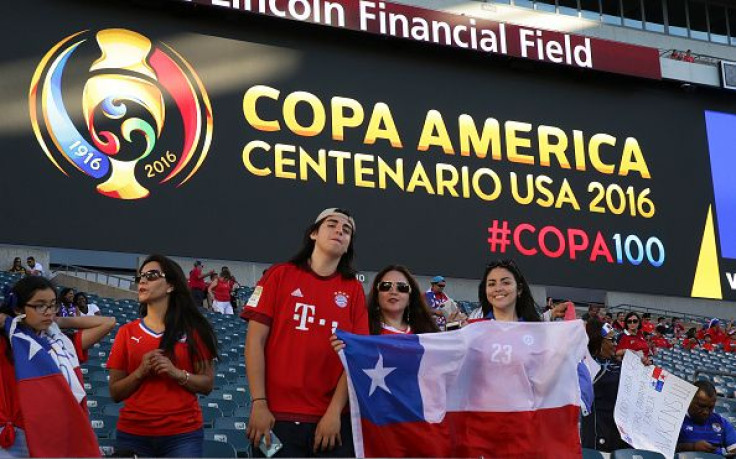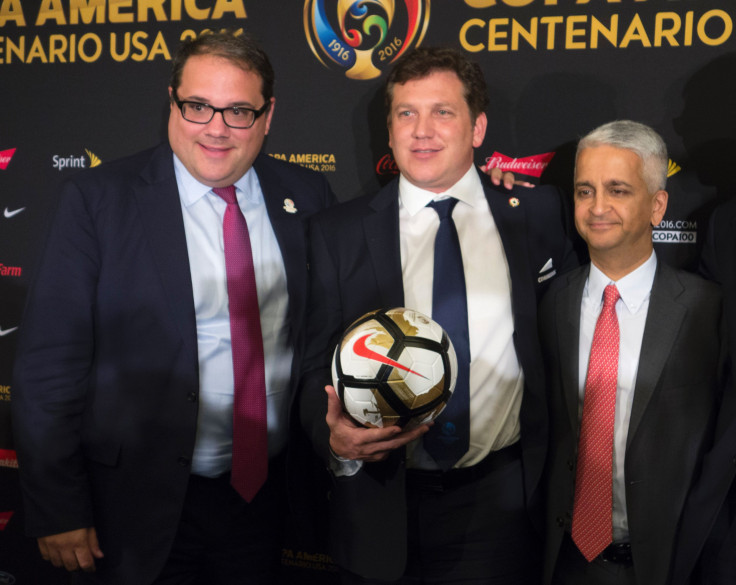Copa America 2016 Attendance, TV Ratings: Could US Host Another Copa America After Centenario Success?

NEW YORK — Embracing record-breaking attendance at the Copa America Centenario, the heads of U.S. Soccer and the governing bodies of Concacaf and Conmebol revealed Friday at a joint news conference they are open to the idea of regular combined competitions between the two confederations of the Americas.
To celebrate its centenary, South America’s championship is being held outside its home continent for the first time, with 32 matches played over three weeks across the United States. The competition concludes in New Jersey on Sunday with the final between Argentina and Chile. And officials from the Local Organizing Committee, Conmebol, South America’s governing body, and Concacaf, the organization in charge of North, Central America and the Caribbean, announced that the tournament had broken new ground. Indeed, records have been set for total and average attendance and television viewership, as well as social media engagement.
With two games remaining, the final and the third-place playoff between the U.S. and Colombia, the organizers expect attendance to top 1.5 million, with an average of 46,000 across the 10 venues. Meanwhile, host broadcaster Fox Sports 1 has set records for its soccer coverage. Tuesday’s semifinal between the U.S. and Lionel Messi’s Argentina attracted 3.29 million viewers, with another 4.8 million tuning in on Univision and Univision Deportes.
The idea of the Copa America being hosted every four years in the U.S. has been mooted. The decision-makers insisted no discussions had been held to that end, and the next tournament, in 2019, is already scheduled for Brazil. But, after such commercial success, top officials from both confederations hinted that the Copa America Centenario may not be a one-off.
"We’re trying for ideas that will help the development of football," said Conmebol president Alejandro Dominguez, who along with his Concacaf counterpart, Victor Montagliani, was elected just this year after both organizations were ravaged by recent FIFA corruption scandals. "With a new generation of leaders, we want to think about projects we can do jointly."
U.S. Soccer president Sunil Gulati was similarly enthusiastic after what was the second highest-attended soccer tournament in the U.S. after the 1994 FIFA World Cup.
"From a U.S. perspective there are two elements: One is participating in Copa America or a similar tournament, two is hosting it. Open to all of them," Gulati said.
The U.S. had previously appeared in three Copa Americas as one of two invitees that supplement the 10 regulars from South America. The last time it entered, though, in 2007, the U.S. took a weakened roster, thanks to Concacaf’s championship, the Gold Cup, taking place in the same year and club teams not having to release non-South American players for the Copa America. There remain plenty of challenges to overcome if regular collaboration is to become a reality.
"The idea of doing a special event that is every four years or every eight years or every 100 years, whatever it might be, that’s something we can look at and talk about," Gulati said. "That would be a situation that FIFA would need to put on the calendar for the non-Conmebol teams. Without that it’s almost impossible to do it. The event has gone well, it’s something we should look at, but we haven’t had any discussions about it."
For all the positives, this Centenario competition hasn’t all been plain sailing. The organization of the tournament itself was a major headache, after its media rights were caught up in the scandal that rocked FIFA in 2015. In terms of the event itself, while Gulati was pleased that the average attendance had greatly exceeded his baseline expectation of 30,000, there has been a vast disparity in attendances.
The decision was made to host all games in NFL stadiums that hold 60,000-plus, with similar ticket prices across the board. That proved a shrewd move for games such as Argentina’s clash with Chile at Levi’s Stadium in Santa Clara, California, that had more than 69,000 fans packed in, or Colombia’s quarterfinal duel with Peru at New Jersey’s MetLife Stadium, which drew 79,000. But there were others, like Paraguay’s encounter with Costa Rica, which drew just 14,000 at the 70,000-capacity Camping World Stadium in Orlando, Florida, where television viewers were greeted by the sight of far more empty seats than occupied ones.
"It’d be nice if you could have dynamic pricing all the time, but how do you do that?" Gulati said. "You have certain matchups are very, very popular in the U.S. and others aren’t, as is the case in every competition. If you’re not going to change pricing after the draw, it’s very hard to get that perfectly right."
Ticket prices attracted particular scrutiny for the U.S. team’s quarterfinal match with Ecuador in the hotbed of American soccer, Seattle, where they ranged from $65 in the nosebleed section to $600. A crowd of 47,000 left 20,000 empty seats.
The tournament has had to contend with the fact that the Copa America has a low profile in the U.S., with previous editions given little coverage. Combined with the ticket prices, there are questions over whether causal sports fans were really being attracted to the event, or if it simply reaping the rewards of the large immigrant communities where soccer is already entrenched.

"You look at everything after the tournament, reanalyze it and you might do things differently," Gulati admitted when questioned about ticket prices. "There’s a big intersection between Hispanic fans and U.S. fans. Most of those fans are American fans; they happen to be Latin."
In comparison to the World Cup, the figures, particularly for television, held up less well. While Univision Deportes reported a higher audience for the group phase of the Copa America Centenario than the same stage of the 2014 World Cup in Brazil, the English-language audience saw a significant reduction. Fox Sports 1’s record numbers of 3.29 million pales in comparison with the 17.3 million who watched the 2014 World Cup final on ABC, or even the average for that competition — 4.6 million across ABC, ESPN and ESPN2.
Still, there is plenty to be satisfied about for an event that was only given the definite go-ahead seven months before it began. That short time frame for organizing a large-scale competition brings the question, not only of whether the U.S. has enhanced its position yet further to host the 2026 World Cup, but also to be on standby if something were to happen to the controversial World Cups in 2018 in Russia and 2022 in Qatar. However, Gulati, also a member of FIFA’s Council, shot down any suggestion of the next two World Cups being moved at this late stage.
"I think the two World Cups have been decided, it will be in Russia and Qatar. We hope [the Copa America Centenario] influences where the 2026 World Cup will be, but that one hasn’t been decided yet."
© Copyright IBTimes 2024. All rights reserved.











